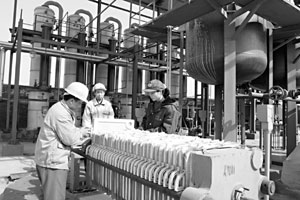|
New tech urged to abate paper making pollution
By Sun Xiaohua (China Daily)
Updated: 2005-11-01 05:47

A petrochemical plant transforms its daily discharge
of waste gas into a material for paper making in Central China's Henan
Province
When Cai Lun invented the technique of paper making 1,900 years ago, he
probably never expected that the development, for all the great achievements it
has led to, would be responsible for extensive environmental degradation.
Today, the paper industry is blamed for huge timber consumption and the
discharge of millions of gallons of toxic waste every year.
At a forum on the environmental issues facing the industry, held recently in
Beijing, experts called for the adoption of technical innovation to combat
pollution and the integration of tree planting into the production process.
Of the first batch of eight environmentally-friendly enterprises appraised by
the State Environmental Protection Administration (SEPA) last year, two were
paper makers - Gold East Paper Co Ltd and Kunshan Banknote Paper Mill in Jiangsu
Province.
"Their achievements show that through technical innovation it is possible for
the paper making industry to shake off its reputation as a destroyer of the
environment and natural resources," said Li Xinmin, vice-director of SEPA's
Pollution Control Department.
However, China's paper making industry is still facing an urgent need to
reduce waste emissions and save natural resources, said Li.
"In 2004, of 41 industrial sectors, the discharge of waste water by the paper
industry ranks second, only chemical plants discharge more," he added.
According to Li, the paper industry produces 3.18 billion tons of waste water
and 1.48 million tons of COD (Chemical Oxygen Demand) each year, accounting for
16 per cent and 33 per cent respectively of the total released by Chinese
industry.
Although the industry is such a major polluter, it only contributes 2.2 per
cent of the country's economic growth.
Most of China's paper making enterprises are in a small scale, producing less
than 10,000 tons per year, way below the world average of 40,000 tons.
The industrial structure also needs to be improved. Currently, at least half
the country's domestic paper products are made from straw pulp, which cannot
make a high-quality product. High-quality paper products made from timber pulp
are mainly produced by joint enterprises or depend on imports.
"The paper industry consumes a lot of resources, especially timber," said
Shen Hanyao, director of the Shanghai-based Warton Economic Institute.
"Production of one ton of art paper needs 4-5 cubic metres of timber. China's
timber resources are not enough to meet the demand."
Because of the insufficient timber supply, the government once advocated the
use of straw pulp. But, the use of straw led to serious pollution.
One ton of pulp made from timber needs less than 30 tons of water and
releases 30-50 kilograms of COD; one ton of pulp made from straw needs 200 tons
of water and discharges 350 kilograms of COD.
Due to the unstable supply of straw, factories using straw pulp are
small-scale and cannot afford the investment needed to install
environmentally-friendly equipment. As a result, said Shen, the country's small
paper factories have become big polluters.
According to an investigation by SEPA, the COD from small-and-medium
paper-making factories is three times the national standard. In Henan Province,
waste water released by about 300 small paper factories accounts for 34 per cent
of the province's total.
Xu Daping, a professor at Beijing Forestry University, blames the country's
shortfall in timber resources on the lack of financial incentives to plant
trees, failure to protect forests and the widespread felling of primeval
forests.
While China does not have enough timber to feed its own industry, exports
continue to grow. "The export, even to countries which are rich in timber
resources, aggravates the shortage of raw materials for the domestic paper
industry," Shen said.
"We should increase the timber pulp used in paper making to improve paper
quality and reduce pollution," said Pu Junwen, a professor at Beijing Forestry
University.
"Planting trees is the first, vital step in paper making. The integration of
tree planting and paper making is necessary for the country to develop its
forestry resources and paper making industry. The planting of fast growing trees
will not only help the paper industry, but also help the country save its
natural forest resources, especially primeval forests," Pu said.
As even fast growing trees take years to reach maturity, new forests do not
just spring up over night. Use of straw pulp cannot be given upin a short time
and the search is on for other environment-friendly materials.
"Reed, bamboo and bluish dogbane can be considered for paper making," Pu
said. "These kinds of raw materials can produce high-quality paper. What's more,
alkali can also be retrieved to help protect the environment."
The country has rich bamboo resources. With plenty of experience in making
paper from straw pulp, the industry can select new raw materials to make up the
shortfall in timber.
Experts have also called for the increased use of recycled paper. In Japan,
about 78 per cent of waste paper can be recycled, and in Germany the figure is
83 per cent. In China, only 30 per cent can be reused. In the United States,
more than 50 kinds of paper products can be recycled, but in China, only books,
cardboard boxes and newspapers can be recycled.
Shen suggested that heavier taxation on exported timber could help limit
exports, and better protect China's own timber resources.
The country should take active measures to protect its forests and give
priority to domestic demands, Shen said.
(China Daily 11/01/2005 page5)
|